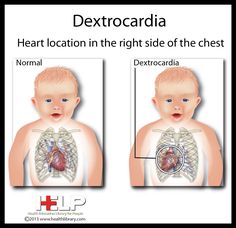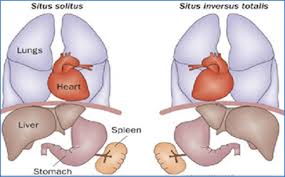A Prodigious Reflection - Dextrocardia
- medicorum sacramentum
- Oct 31, 2021
- 4 min read
‘Dextro’ is a Latin prefix to mean ‘on the right side’ therefore dextrocardia refers to the extremely rare phenomenon of a person's heart pointing to the right side instead of the left. This small change in the body can lead to many fatal complications.
What is dextrocardia?
Dextrocardia is a rare heart condition in which the heart points towards the right side of your chest. This condition has only occurred in only less than 1% of the world population leaving us with several questions about it.
There are two main types of dextrocardia: Dextrocardia situs inversus and Dextrocardia with situs inversus totalis.
Dextrocardia with situs inversus is when only the tip of the heart along with its 4 chambers are pointing to the right side of the chest rather than the left side.
Dextrocardia situs inversus totalis refers to the mirror imaging of all the chest, abdominal and vessels along with the heart and at times the spleen is missing. (the spleen is an organ that fights pathogens in the blood)
Causes and symptoms
Dextrocardia situs inversus occurs in about 1 out of every 12,000 people and dextrocardia situs inversus occurs in 1 out of every 10,000 people. It is more common for other organs in the body to mirror the heart for easier cardiovascular connections.
Dextrocardia has been proven to occur during early pregnancy (when the heart develops). It can be associated with other disorders such as Kartagener syndrome( where dextrocardia is accompanied with ciliary dyskinesia, this is when the cilia that move the mucus are immobile) or it is caused by a recessive gene (one that is only expressed in the presence of another recessive gene). The expression of this gene causes the cardiac tube to reverse direction during fetal growth then according to the time and extent of reversal the organs also reverse. For example, the liver would move to the left side instead of the right.
Dextrocardia in any of the two forms is not alarming in general, many people live their lives without realising they have it, its discovery usually would happen during x-rays and other examinations due to other unrelated complications. The easiest way to detect dextrocardia is to see if you can hear a stronger heartbeat on the right or left side of your chest.
Symptoms shown in some adults:
bowel disorders, usually from obstruction due to malrotation (reversal)
bronchial diseases such as pneumonia
esophageal disorders such as asthma associated with GERD
cardiovascular disorders like arrhythmias.
heart failure or disease
infection and sepsis
Severe symptoms that require medical attention are most common in infants:
unexplained and continual exhaustion
inability to gain weight
chronic infections, especially of the sinus and lungs
difficulty breathing
jaundiced or yellowed skin
blue-tinted skin, especially around the fingers and toes
It is important to note that symptoms can also be due to the associated disorder! For instance, someone with Kartagener syndrome would show bronchial diseases and infections due to the immobilised cilia and lack of a spleen. Mirroring the organs does not directly cause much harm.
The Tricky Part
The biggest problem with dextrocardia is that the mirroring of the organs makes detection of other infections/diseases becomes much harder.
For example, a person with dextrocardia will face severe pain on the bottom left abdomen instead of the bottom right if he has appendicitis. This will lead to the wrong diagnosis and can lead to infections getting much worse. However, even if one did alert doctors about their dextrocardia and get the right diagnosis the surgery to remove his appendix would be difficult.
When surgeons are trained they use normal human bodies and a mirror image one would be extremely hard to deal with.
Treatment
Dextrocardia is a rare condition that completely changes your anatomy however it is one you can live with. Cases of dextrocardia have led a normal life and it should only be treated when one of the above symptoms appear, they each have a unique treatment plan. Normally, long term usage of antibiotics may be prescribed as patients with dextrocardia have a higher risk of infections.
Many of you may jump to the thought of just placing organs in the normal way by surgery but this is an extremely high-risk and difficult surgery that cannot take place.
Brief case studies
Here are two case studies showcasing the symptoms and the diagnosis of dextrocardia just as discussed above.
A 59-year-old man was experiencing lower urinary tract obstruction. After examination, a diagnosis of hydronephrosis was made (the swelling of a kidney due to a build-up of urine). This requires an invasive treatment plan therefore in preparation for it the x-ray scans lead to the discovery of his dextrocardia situs inversus totalis.
A 7-month old baby had come into the Emergency Room and the parents reported cough and cold for the past 5 days, fast breathing with chest retraction (lack of air pressure causes the skin and soft tissue in your chest wall to sink in) and refusal to eat. Upon arrival, she was just slightly warm and such an episode had never occurred before. Then during the examination, her heart was louder on the right side leading to further exams done such as echocardiography which all pointed towards dextrocardia and finally, an X-ray concluded that her heart was in the right hemithorax. Next, an abdominal sonogram showed her liver and stomach on the wrong sides and her spleen was completely missing. She was diagnosed with dextrocardia situs inversus totalis.
Written by: Sakshi Deshpande
Edited by: Svasti Tewari
Bibliography









Comments